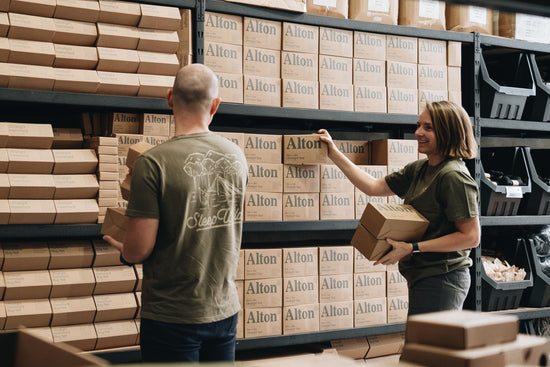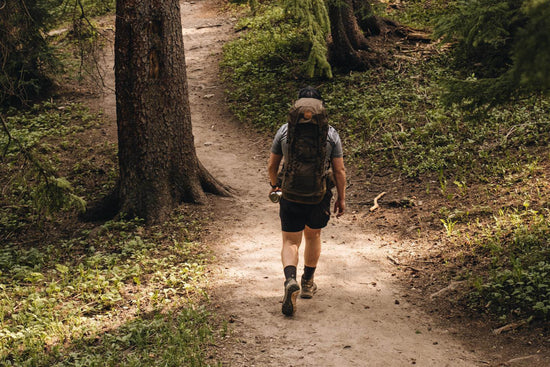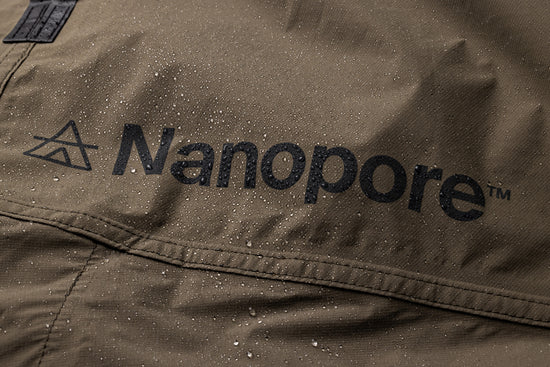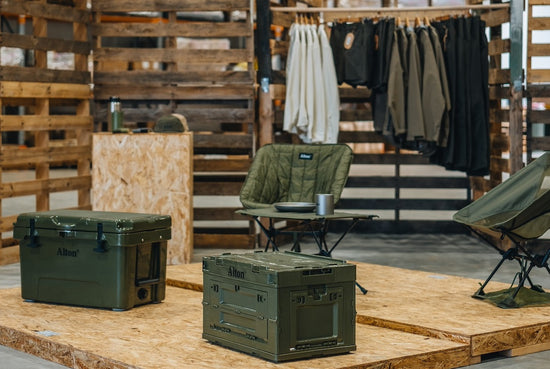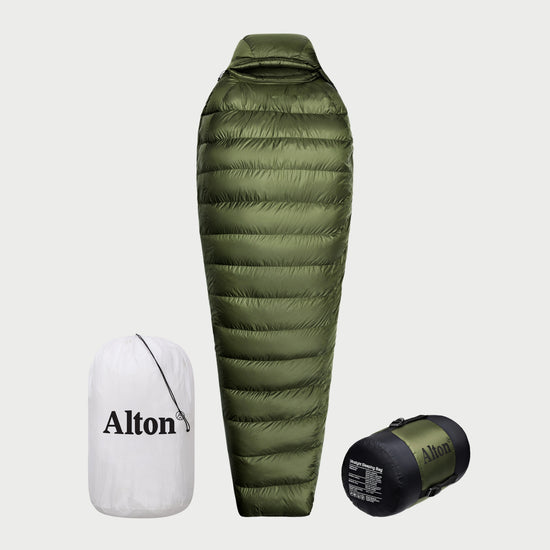























-
Ships in 24 hrs
-
Easy returns
-
Lifetime Warranty*
Frequently bought together
-
Insulated Sleeping Mat (R4) Set
$261.00 $290.00
-
Ultralight Sleeping Bag
$595.00
ALL ALTON PRODUCTS ARE COVERED BY A LIFETIME WARRANTY.* CLICK HERE TO LEARN MORE.
ALL ALTON PRODUCTS ARE COVERED BY A LIFETIME WARRANTY.* CLICK HERE TO LEARN MORE.
ALL ALTON PRODUCTS ARE COVERED BY A LIFETIME WARRANTY.* CLICK HERE TO LEARN MORE.
ALL ALTON PRODUCTS ARE COVERED BY A LIFETIME WARRANTY.* CLICK HERE TO LEARN MORE.
Explore Product Features
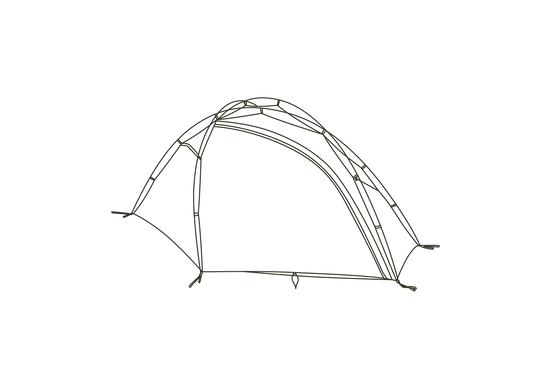
Dyneema® 0.75 STRENGTHplus+
Dyneema® 0.75 STRENGTHplus+

Spacious 1.5 Person Capacity
Spacious 1.5 Person Capacity

Built For The Wilderness
Built For The Wilderness

Freestanding Tri-Pole Geometry
Freestanding Tri-Pole Geometry

Specifications
| Capacity | 1 - 1.5 Person |
| Season Rating | 3.5 Season |
| Floor Dimensions | 207cm (Length) × 65cm (Head Width) × 100cm (Middle Width) × 48cm (Foot Width) |
| Floor Area | 1.614m² |
| Internal Height | 102cm (at highest point) |
| Vestibule Width | 60cm (at widest point) |
| Fly Material | 25gsm Dyneema® Composite Fabric 0.75 (20,000mm HH) |
| Inner Material | 15D Nylon + 10D Nylon Micromesh |
| Floor Material | 20D Ripstop Nylon, Silicon/PU coating (2,500mm HH) |
| Trail Weight (Tent + Poles + 6 Pegs) | 1.049kg |
| Total Packed Weight | 1.234kg |
| Total Packed Dimensions | 41 × 11 × 11cm |
| Collapsed pole length | 39cm |
| Poles | 8.6mm Carbon Fibre Poles |
| Pegs | DAC Featherlite® J-Stake (F) (7g) |
What's included
1 × OUTER FLY TENT
1 × INNER TENT
11 x DAC FEATHERLITE® J-STAKE (F) PEGS
3 x CARBON FIBRE POLES
3 x KNOTLESS ADJUSTABLE GUYLINES
1 x SIDE ENTRY COMPRESSION CARRY BAG
A Dyneema® Tent, Done The Alton Way
When we began developing our Ultralight 1P Tent, we knew that we wanted to bring out a Dyneema® version and integrated that into our design process from the very start. But we also knew that we wanted our Ultralight Dyneema® Tent to reflect our approach to making gear. That meant it had to be functional, durable and long-lasting, as well as ultralight. With a trail weight of just 1.049kg, our Ultralight Dyneema® 1P Tent isn’t the lightest model on the market, but we were never chasing the lowest number on a scale. We were chasing better performance in the wild, across the board. And that’s exactly what sets our Dyneema® Tent apart from the competition.

Premium Materials That Serve A Purpose
Every aspect of our Dyneema® Tent has been designed to deliver the best performance, not just the lowest number on the scale. Take our fabric choice, Dyneema® 0.75 (25 gsm), with 65% higher tensile strength, 60% greater puncture resistance compared to the sub-22 gsm fabrics found in most Dyneema® shelters. For the floor, we’ve opted for 20D ripstop nylon, which adds durability in a critical area and is easier to repair, improving longevity. Then there’s the 8.6mm carbon poles, which are engineered to flex without breaking, splintering or fracturing. The result is a spacious, double-wall, freestanding Ultralight Dyneema® 1P Tent that weighs in at just 1.049kg.

Expert Construction, Small Batch Production
We work with an experienced Dyneema® manufacturing team that understands the precision this material demands. The Dyneema® outer fly is hot-bonded, creating seams that are stronger and more reliable in variable conditions. Before bonding, the Dyneema® panels are pre-shrunk so that they retain their shape through heat, cold, and years of regular use. On top of this, the Ultralight 1P Dyneema® Tent is produced in small batches that are subjected to strict quality controls at every stage of fulfilment and come with a Lifetime Warranty* against defects and manufacturing faults to prove it.

External Frame Architecture For Versatile Performance
Our Ultralight Dyneema® Tent’s external architecture isn’t just for show. First, the tri-pole geometry reinforces the shelter from the outside, making it more resistant to wind and snow loading. Second, the central transverse pole makes it significantly more spacious than your typical 1-person tent, with 1.614m2 of interior floor space and 0.88m2 under the vestibule. Finally, the external frame allows you to set up in a number of ways, depending your needs and the conditions. You can pitch fly first or with the inner pre-connected, ensuring that your sleeping area stays dry. If desired, the outer fly can be used alone, giving you a minimalist single-layer shelter that weighs just 669g.

Double Wall Comfort & Condensation Management
As one of the only double-wall Dyneema® 1-person tents on the market, our Ultralight Dyneema® Tent avoids one of the biggest drawbacks of our single-wall rivals: condensation. It features a nylon micromesh inner with a durable ripstop nylon bathtub-style floor and the waterproof Dyneema® outer fly (+15,000mm hydrostatic head). Along with the dual vents at the apex of the shelter, this true double-wall construction delivers superior storm security and condensation control, while still keeping the overall weight impressively low. No more wiping down walls or waking up in a damp sleeping bag – with Alton’s Ultralight Dyneema® 1P Tent, you’re all set for a drier, more comfortable camping experience.

Made with Sustainability in Mind
By carefully selecting stronger materials and prioritising quality at every stage of development, we’ve created an Ultralight Dyneema® Tent that is purpose-built with long-term functionality and repairability in mind. Dyneema® 0.75 is produced with bio-circular raw materials using 100% renewable electricity, dramatically reducing the environmental footprint of the fabric. Made in accordance with industry-leading quality compliance and sustainability standards, it’s certified by the International Sustainability & Carbon Certification, ensuring end-to-end sustainability, traceability and quality control.

Tent Footprint Add-On
Unlock extra functionality and protection with the Footprint add-on. Cut to match the exact floor profile of the Ultralight 1P Tent and Ultralight 1P Dyneema® Tent, this Footprint acts as a durable barrier against mud, moisture, and sharp debris. Unlike standard footprints, our design features a built-in doormat panel that extends under the vestibule. This gives you a convenient place to take off your boots, kneel to organise gear, or step outside of the tent in the middle of the night without getting your socks dirty. Constructed from a hard-wearing, waterproof ripstop nylon, it clips into place beneath the tent and packs down small when not in use.

FAQ's
-
Tent season ratings are intended to provide a rough guideline for what conditions a specific tent is suitable for.
A 3-season tent is designed for use in spring, summer, and autumn conditions. Most 3-season tents will feature a full or partial mesh interior and a waterproof tent fly, enabling you to adapt the level of coverage to suit the conditions. However, a 3-season tent is not intended for use in snow, and may lack some of the structural resilience required to handle harsh winter weather and below freezing temperatures.
A 3.5-season tent is built to handle more demanding conditions, including light snow loads, strong wind, and heavy rain. The materials will generally be slightly stronger and more durable than those found in a 3-season tent, and the design may vary to prioritise stability and weatherproofing.
A 4-season tent takes things up a notch. They are specifically designed to deal with extremely strong winds, heavy snow loads, and winter storms.
-
Whether or not a 1-person tent is worth it or not really depends on how you like to camp. If you’re someone who often goes on solo trips or who prefers not to share a tent, then having a 1-person tent is probably the most efficient option for you.
With a 1-person tent, you can save weight and space in your pack, lightening your load so you have more capacity to carry other essentials. They’re also great when you are camping in rough terrain, where campsite space may be limited, as a 1-person tent can be pitched in places where a 2-person or 3-person tent just wouldn’t fit.
For these reasons, 1-person tents tend to be the preferred option among solo hikers, bikepackers, bushcrafters, and hunters.
-
If you spend any time on Ultralight internet forums, you will start to notice that there are a lot of very strong opinions about what tent weight is considered ultralight (and what isn’t).
The truth is, there is no universal definition or rule about what is ‘ultralight’, but the current consensus seems to be that a 1-person should weigh under 1.5kg in order to be considered ultralight. However, some people would say this is too heavy, and to be considered truly ultralight a 1-person tent should be under 1kg.
While it is possible to find 1-person tents that weigh under 1kg, they usually come with significant compromises. Many use hiking poles instead of traditional pole structures, or incorporate ultra-premium materials such as Dyneema® composite fabrics and carbon fibre tent poles. This is often why the lightest ultralight tents are eye-wateringly expensive, too.
When you start getting into the extreme end of ultralight (under 1kg), there is also often reduction in durability, and longevity, by extension. Given the potential price tag and environmental impact of replacing an ultralight tent every few seasons, many people find they’re better off with a slightly heavier option that’s more robust. But at the end of the day, it's your choice how light you want to go.
-
The waterproof rating of a tent is called the hydrostatic head, which refers to how much water pressure (measured in millimetres) the fabric can withstand before it starts to leak.
To put that in real terms, a tent fly with a 1,500mm hydrostatic head rating can hold a 1.5m column of water before any moisture begins to seep through.
The higher the hydrostatic head rating, the more water pressure the fabric can resist. But higher doesn’t always equate to “better”.
Higher hydrostatic head ratings (over 2,000mm) typically require thicker fabrics and extra layers of coatings to achieve that level of waterproofing, which can result in the tent being much heavier, stiffer, and bulkier when packed.
And while some ultralight fabrics such as Dyneema Composite Fabrics are highly waterproof, they are less durable and considerably more expensive than silnylon alternatives.
Tents with higher hydrostatic head ratings tend to be much less breathable, making them more susceptible to condensation, so you end up feeling damp inside the tent, anyway.
For all these reasons, going for the highest hydrostatic head rating won’t always mean you’re going to get a better tent. Instead, we recommend focusing on the quality of the fabric and construction, coating type, seam sealing, and overall design, as these all play a huge role in how dry your tent will stay in real world conditions.
A high-quality tent with a hydrostatic head rating between 1,200-1,800mm for the outer fly and 2,000-2,500mm for the floor is more than enough waterproof protection for typical outdoor conditions, including rain, wind, and yes, even the occasional storm.
If you regularly camp in severe conditions, including high winds, prolonged or driving rain, heavy snowfall, or severe storms, then a hydrostatic head rating of 2,000-3,000mm for the outer fly and over 5,000mm for the floor may be advisable.
-
Before we answer this question, it’s worth clarifying what “10D” actually means. 10D is referring to the fabrics denier, which is the standard unit of weight for a single thread/yarn of any given fabric.
The dernier number is based on the weight of 9km (don’t ask why) of a thread of a specific thickness. So, 9km of a 10D thread weighs 10g, and 9km of a 20D thread is 20g, and so on.
As you can see, the denier tells us how heavy an individual thread of fabric is… but not much else. This is why you can have two 10D fabrics made from different materials, with completely different weights, thicknesses and durability levels.
When it comes to judging how durable a tent’s fabric is, denier is just one tiny piece of the puzzle. Other factors like the material (eg. ripstop nylon vs polyester), thread count, weave pattern, and coating composition are also important.
Our Ultralight Tent’s outer fly is made from 10D ripstop nylon with a 1,500mm silicone/PU coating, and the floor is made from a 20D ripstop nylon with a 2,000mm silicone/PU coating.
We utilise a high-tenacity ripstop nylon with a square grid, meaning there are thicker, stronger threads woven in a square grid pattern throughout the fabric. Combined with a high thread count, this dramatically increases the tear strength while keeping the overall weight very low.
Then there’s our dual silicone/PU coating. We’ve specially formulated the coatings to offer the best performance and longevity in outdoor settings. Not only is this coating waterproof, it also increases the tear strength, UV-resistance and durability of the fabric. The silicone coating soaks in and bonds with the fabric, rather than just sitting on top.
On the inside of the tent fly and floor, we’ve opted for a thin polyurethane (PU) layer, which provides better adhesion with seam tapes, ensuring fewer potential leak points. This also reduces some of the slipperiness that can come with silicone coated tent floors.
So 10D outer fly and 20D floor might not sound like much, but the reality is that it’s not the denier that makes this fabric exceptionally durable, but all these elements working together.
But “durable” doesn’t mean indestructible.
Your Ultralight Tent can (and will) still sustain damage if it’s stabbed by sharp branches, dragged over debris, or exposed to heavy abrasion. We recommend using the Ultralight Footprint to protect the tent floor, and avoid setting up in places where shrubs or branches are rubbing against the fly.
We back our Ultralight Tents with a Lifetime Warranty* against manufacturing defects in materials or workmanship, but that’s not a free pass to abuse it. Take care of your tent, and it will take you further.
-
Knowing how to properly clean and care for your tent is an important outdoor skill and can help keep your tent functioning for longer.
After each trip, we recommend unpacking your tent and allowing it to air dry in a well-ventilated area out of direct sunlight. Leave it until it is completely dry, as packing it away while damp can damage the fabric or lead to mould growth over time.
At the same time, take the opportunity to give it a spot clean. To do this, shake or brush out any debris, then use a soft cloth with a cleaning solution that’s formulated for outdoor gear, such as Nikwax Tech Wash®, to clean any dirt or marks you can see on the fabric.
If a deep clean is required, this should always be done by hand. Fill your bathtub or a large bucket of water with lukewarm water and add some suitable technical wash, using the dilution ratio specified on the bottle. Work over the fabric using a sponge or soft cloth, then rinse thoroughly to remove any soap residue. Gently wipe off the excess water with a towel first, then hang on the clothesline or on a rack and leave to air dry completely.
If you use your tent frequently (30+ nights per year), we recommend applying a waterproofing or solar-protective treatment, such as Nikwax SolarProof® once a season.
